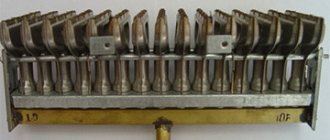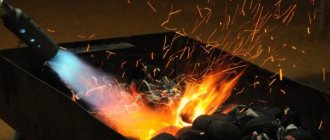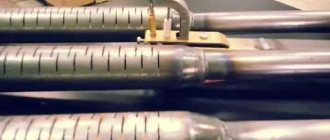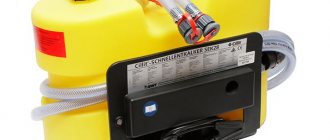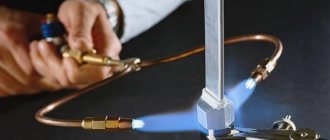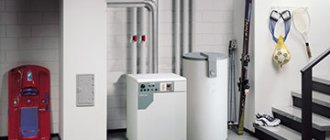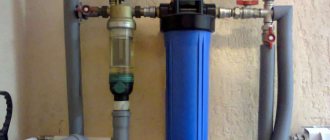Design and principle of operation
The principle of operation of such a device is simple - gas, using an ejector, passes into the internal cavity at high speed, which allows air to be drawn into its volume, mixing it with gas.
Through distribution pipes, the finished gas-air mixture flows to the holes, at the exit of which it is ignited using a special ignition device. Most household heating boilers use a piezo igniter
Basic nodes:
- nozzle device;
- igniter or piezo ignition;
- primary sensor that monitors the presence of flame.
What to look for when choosing?
If the purchase of a device is due to the desire to convert a solid fuel boiler to gas fuel, its power should significantly exceed the power of the firebox.
It is also necessary to take into account the compatibility of the boiler and burner.
So, for example, not every “solid fuel” can be converted to install a fan burner, and in boilers such as, for example, “DON”, it is impractical to install them due to insufficient thermal insulation of the boiler tank.
The nature of the movement of the gas-air mixture has an important influence on the operation of the burner. Based on this feature, these devices are divided into straight-flow and twisted. The latter are characterized by a more powerful air flow.
Types of gas burners for boilers
The boiler design and burner devices are closely related. The boiler manufacturer usually produces it independently for the boiler or completes it with a strictly defined model that works to ensure thermal balance.
It is not permissible to change or reconstruct such devices, since this may create an emergency explosive situation during the operation of gas equipment.
Classification of gas burner devices:
- atmospheric type, usually used in units with an open combustion chamber of low thermal power;
- fan or supercharged for a closed firebox, used in powerful boilers;
- with a constantly working ignition device;
- with piezo ignition.
In addition, there are combined fuel oil burners for boilers that can operate on two types of fuel: gas and fuel oil, for example, the GMG gas and oil burner.
Fan
Such devices are energy-dependent and operate with a forced supply of oxygen from the air. The designs of such burners allow for more precise mixing of two media, so the combustion process proceeds with the highest quality.
The burners are installed in domestic units with a significant heat load and in industrial applications used for central heating, for example as an oil burner for a boiler.
They are mainly used on DE 16 14 boilers that produce saturated steam. Such medium pressure devices are equipped with automation that allows you to control the operation. For example, GMG 4 or 4m burners and GMG 5 burner are equipped with flame control sensors. When the torch comes off, such a unit turns off automatically.
Gas and oil burners operating on two types of fuel have an additional unit that performs preliminary preparation of fuel oil: it cleans it of suspended solids and heats it to approximately 70 C, thereby reducing its viscosity.
Atmospheric gas burners
This structural type of burner device is the simplest, which greatly facilitates the operation of the boiler. They function thanks to the natural suction and mixing of air.
The combustion products of the fuel mixture are removed through chimneys. The air in them comes directly from the room, which must have good supply and exhaust ventilation, with 3 times air circulation in the combustion chamber.
Such devices have their main advantage - energy independence, that is, they can function without power supply. They have the lowest efficiency of all available models due to their low ability to effectively mix gas and air.
Diffusion kinetic
Diffusion-kinetic devices are an intermediate option between atmospheric and fan. They are used mainly in industrial gas boiler houses.
Combined burner devices are used for units using two types of fuel - gas and fuel oil or heating oil. They are considered more efficient, have a good range for regulating the unit load from 15 to 105% and are equipped with automatic safety.
Primary requirements
We list the signs of a high-quality gas burner:
- The fuel burns completely: this requirement is very important, since incomplete combustion of gas not only reduces the efficiency of the heater, but also pollutes the atmosphere with nitrogen oxide and carbon monoxide.
- The device has a fairly long service life.
- The design is extremely simple, installation is not difficult.
- The noise emitted by the burner does not exceed the values permitted by sanitary standards.
If the burner is a combination burner, that is, it is capable of working with different types of fuel, then it should be quickly and easily switched to one or another type of fuel.
Classification by air supply method
The supply, volume and quality of mixing air with gas is the basis for the effective operation of the device, and this will determine whether it can reach its standard indicators for thermal power and efficiency.
Devices are grouped according to the method of air supply:
- blowless - air masses are supplied to the mouth of the burner due to vacuum in the combustion chamber;
- injection, in which air flows are drawn to the mouth of the burner for heating boilers by a gas stream;
- blowing, combustion air enters the firebox using a centrifugal fan.
Low temperature
In boilers with open fireboxes, atmospheric type devices are installed. The principle of their operation is quite simple. Gas under pressure in the line enters the igniter through the ejector device, thereby drawing in air from the combustion chamber.
Ignition is carried out by a small volume of low-temperature flame from the igniter wick. This option is used for low-power household heaters. They have low cost, easy operation and operate with low noise levels.
Injection burner for boiler
These gas burner designs have increased thermal power. The efficiency of their work is due to the fact that even before the gas enters the chamber, it is enriched with oxygen from the air.
The production of the working mixture is carried out in several stages. A liquid fuel roof burner works on this principle.
The design of such a gas burner apparatus is made of a number of hollow channels - nozzles, through which gas flows with enormous pressure, thereby injecting (sucking in) the air masses present in the combustion chamber.
A similar mixture burns in the form of small-sized torches, which is why they are also called micro-flares. In the firebox, the igniter or pilot nozzle operates all the time. Compared to blowing options, this model consumes up to 20% more gas.
Dutyevaya
In closed fireboxes, air is supplied by blower fans. Such burner options are not universal, but are designed for a specific boiler, for example, like a GGS gas burner.
For the owner of individual heating, this is a huge advantage, because such a device comes with the basic configuration of the boiler and does not need to be specially installed and configured.
The burner block is equipped with the following components:
- gas purification filter;
- gas pressure regulator;
- gas flow regulator;
- gas reducer;
- primary sensors;
- electric relay for automatically turning off/on the burner device based on the results of setting the boiler;
- fan electric relay stops the gas supply when the blower motor is turned off.
Such a system is volatile, so experts recommend installing a backup power supply in the form of an uninterruptible power supply during its operation.
Variations with two stages
To arrange the operation of a two-stage burner, there are two modes or varying fire power. If using one stage the boiler operates at its maximum, then when switching to the second stage, productivity is reduced by 50-60%.
Variation of modes in boilers is carried out automatically based on a signal from special sensors. They control the temperature of the coolant. Also, modes can change when the gas pressure in the main network changes.
Switching the boiler to a less tormenting mode has certain advantages:
- There is a saving of gas or other fuel.
- All equipment develops an operational period, as the number of starts and stops decreases.
A device with two stages can have a smooth change of modes.
How to clean a gas burner
The nozzle on a gas boiler is considered one of its main components. In order for the technological process to proceed without disruption, it is necessary to keep the working elements of the boiler burner clean, otherwise it will be necessary to carry out serious repairs to the gas burner of the boiler. These measures are carried out for preventive purposes, as well as when it does not light up.
Before cleaning it, you need to turn off the gas supply.
Algorithm for cleaning the burner device from soot:
- Disconnect the ignition button wire.
- Remove the thermocouple clamping device.
- Mark with a marker the level of the nozzle entrance to the burner device in order to later install it in the desired location.
- Unscrew the nut that connects the valve to the device.
- The piezo igniter is turned off in the same way.
- Remove the nozzle.
- Proceed to the cleaning process with a brush and a stiff brush.
- When the carbon deposits are removed, blow out the holes with a vacuum cleaner.
- Next, the burner is installed in the boiler.
Conclusion
When purchasing a boiler, you need to pay attention not only to its power and automation functionality, but also to the modification of the gas burner.
Its choice when re-equipping a heating boiler is made taking into account the size of the combustion chamber. If you do not take into account the correspondence of its dimensions to the linear parameters of the burner, burning through the metal, and in a short time, is guaranteed.
Taking into account the variety of engineering solutions and the range of devices, consulting a professional on this issue will come in handy.
In the online store alfatep.ru gas burners are presented in a large assortment. All devices are from manufacturers with an impeccable reputation. Direct deliveries allow us to keep prices low. We have experienced specialists who are ready to provide advice in choosing a burner for a specific boiler model. You can contact them by phone or through the “Feedback” option on the website. An extensive network of representative offices in the regions allows us to organize delivery of goods to the client in a short time.
DIY gas boiler burner
It is not difficult to make a burner yourself, but experts do not recommend doing this, especially for factory-made boilers, in which the calculation of the gas burner for the boiler was carried out professionally by the equipment manufacturer.
This process requires very careful calculations because even the slightest mistake will lead to poor quality of fuel combustion and even to a boiler explosion.
Sometimes, when the user has a solid fuel unit that runs on wood, and there is a design possibility, an atmospheric gas device is installed in it.
To use this module, you do not need to radically rearrange the unit, but use an ash chamber. Automation is installed for control and adjustment processes. It is better to select a burner based on thermal power, factory-made.
Modulating options
Modulating multi-fuel burner
Modulating versions are characterized by the highest practicality and economy. Their work is based on smoothly controlling the burning fire. As a result, the power of the heating unit is concentrated in the range of 10 - 100%.
According to the method of flame control, these devices are divided into the following burners:
- having mechanical control technology;
- having pneumatic technology;
- versions with electronic control.
The strengths of modulated versions lie in the least cyclical on-off operations. This has a positive effect on the productivity of all heating equipment and its operating period.
Also, when work is carried out with boilers equipped with modulating gas generators, a certain fuel saving is achieved - 15%. Here it is also important to properly configure the equipment.
Modulation gas generators can be used in working boilers with this and other types of burners. This eliminates the need to replace a rather expensive unit. All you need to do is purchase the burner itself and call a specialist to install it and configure the entire technology.
Manufacturing parameters
Before assembling the burner, you should determine in advance the required parameters, the main ones of which are:
- Flame type – torch or vortex. The design of flameless burners is too complex to make at home. The torch flame affects a small area and is used for precision welding. Using a vortex, you can quickly heat large surface areas.
- Flame adjustment device. The regulator allows you to reduce sludge and increase flow depending on the material and processing method. A water valve can be used for control.
